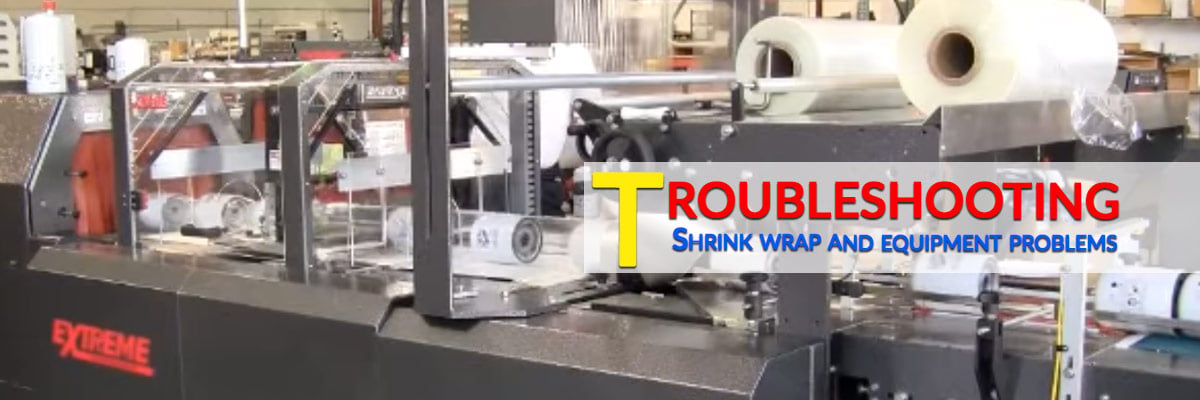Troubleshooting Shrink Wrap And Equipment
Equipment | Technical Service and Support | Plant Performance
Whether you’re in food service or consumer packaged goods, shrink wrap is an amazing tool.
It’s customizable, efficient, and protects your products as they travel. It’s been an incredibly useful development in the manufacturing space.
But if your shrink wrap system isn’t working to its full potential, you could be wasting money, time, and manpower. Issues with shrink wrap could even damage your reputation with customers.
Common shrink wrap issues tend to fall back on three issues: temperature, time, and pressure. Read on to assess your shrink wrap status and troubleshoot any common shrink wrap problems you may have with your equipment or line.
The Most Common Shrink Wrap Problems
Shrink wrap has an array of uses, from protecting products from moisture and dust, to reducing environmental impact and adding retail appeal. But certain problems can pop up, negatively affecting your bottom line.
Are you having shrink wrap problems? Download our free Shrink Wrap Cheat Sheet!
Before you start delving into the troubleshooting process, however, it’s best to do a quick test to see if the issue lies with the machinery or the shrink film itself.
First, make an empty shrink bag using your existing settings.
Second, assess the bag seals. If they’re good, the shrink film may just be sized incorrectly for the product. If they’re bad, it’s a mechanical issue, and you can move on to figuring out what component needs to be fixed or adjusted.
Temperature issues (either too hot or too cold) cause the most common shrink wrap problems.
Sometimes, problems are caused by a combination of temperature, pressure, and time, so read on to see how you can fix what’s gone awry.
Troubleshooting Temperature
If temperature is the issue, it will likely show itself in a number of ways.
As a first step, it’s best to identify your sealer’s perfect temperature. To do this, run the sealer at its lowest possible temperature until the film won’t cut, Then, raise the temperature from 5°F-20°F until consistent seals are reached at the chosen line speed.
Common shrink wrap problems related to temperature include:
● Flat Films Not Coming Off The Roll
○ When layers of flat film stick together, it’s called “blocking.” Usually, the film has been in excessive storage temperatures, which causes it to fuse together.
● Jagged Seals Or Incomplete Cut-Offs
○ Seals that look torn, incomplete, or jagged suggest that seal temperatures are too low. Try turning the heat up in 25°F increments until the film has a clean seal and sharp cut-off.
● Shrink Bags Take Too Long To Seal
○ Dwell time (how long it takes for film to seal when the seal jaws are closed) varies. If dwell times are rising, it suggests that the temperature is too low, and vice versa.
● Strands Known As “Angel Hair” Start Showing Up Near The Seal
○ Strands that look like hair can appear between the sealed shrink film and the sealing mechanism. These are caused by the sealing wire or seal bar not being hot enough.
● Smoking Film Or Build Up
○ Smoking and polymer build-up on a pad demonstrate excessive heat. Worn pads can also create polymer buildup and smoking. It’s best to reduce excessive sealing head pressure and align them.
● Whitened Film Or Burn Holes On Packaging
○ This is likely due to overheated film. In this case, you should increase conveyor speeds and reduce tunnel temps. Also check for too much air velocity, improperly directed air flow or clogged screens in the tunnel, all of which can lead to package rejects. Lastly, make sure the film doesn’t touch the walls or ceiling of the tunnel.
● Weak Seals Or Pinholes
○ Small brittle seals (frequently with pinholes and open areas) suggest that the seal temperature is too hot. When that’s the case, film will typically crystallize near the seal area. Look for parallel white lines about 1/16” from the seal.
● Ballooning Film
○ The balloon effect occurs when the shrink film is exposed to hot air after sealing. The air inside of the bag expands and causes the shrink film to blow up. This can be addressed by using film with vent holes (aka pre-perforated film) that allows air to escape as the film shrinks around the product.
● Wrinkled Or Sagging Film
○ If you’re seeing wrinkles or sags (known as “crow’s feet”) at the corners of packages, slow the conveyor, increase the tunnel temperatures, decrease air evacuation and redirect the airflow to the saggy spots. You can also try using a lower number of perforations, or placing them in different areas of the package.
● “Fish Eyes”
○ This term refers to round or oval patterns on the surface of plastic on a package that was shrunk poorly due to lack of heat. Turn up the tunnel temperature and speed up the conveyor a little bit. It’s also possible that you’ll need to reduce air flow and use slightly less film around the package.
● The Machine Creates Shocks
○ Shocks means static electricity is at work or electro-static discharge (ESD). Matted film, film tracking, and tension issues can also be caused by static. To check for the presence of static, hold a small piece of film about one inch from a conductive surface (like the machine’s frame). If the film is attracted to the surface, it’s charged.
○ As a fix, keep equipment grounded by using three-prong plugs. Also, insure the machine frame is connected to a grounding source (such as a metal pipe or a drain). Polished or shiny surfaces can produce static and create film drag, but you can solve that issue by roughing them up with sandpaper. Static eliminators are also an option.
Troubleshooting Time
When timing isn’t right with the machinery settings, certain problems will frequently pop up with shrink wrap.
These include:
● Flaps Of Film Along Seal Corners
○ To reduce the appearance of “dog ears," increase air evacuation by making sure perforations are strategically placed. Also, cut down your bag size. Then, slow the conveyor speed while increasing the air velocity and tunnel temperature. Lastly, redirect the tunnel’s air flow to the ends of the package.
● Curled Or Damaged Products
○ If the film is damaging the product, it’s often related to tunnel parameters or overly aggressive film force. Try allowing more film around the package, increasing the conveyor speed, turning down the temperature, and reducing air flow. If that doesn’t work, consider switching to a lower energy film with a more gentle shrink force.
● Seals Failing In The Tunnel
○ Check the package to reduce film tension near the seal area; increase air flow through different perforations; or increase the size of the shrink bag. Next, check the tunnel to make sure all air intake screens are clear of melted polymer; heater banks are working properly; blowers are turned the right way; and the temperature control is functional.
Troubleshooting Pressure and Tension
Pressure is a key factor when it comes to adjusting your machinery. Improper seal pressure or tension can cause common shrink wrap problems.
If you’re seeing any of the following issues, pressure is likely a factor:
● Seals Are Uneven Or Show Voids
○ Seal jaw pressure is perfected when machines are built, but worn parts or misaligned jaws can affect it over time. As a test, put a white piece of paper in the seal area and engage the jaws to lower and seal. If pressure is even, a uniform line should be formed on the paper. If that line is dotted or has gaps, the jaws may have maintenance issues. If lines in the film clamp area aren’t parallel, it means one of the film clamps may be hitting off the pad.
● Split Seals
○ This can be caused by too-thin film, or a bad roll of film; check to make sure it doesn’t have unnecessary perforations or holes, or that the perforations are properly placed. Clean your sealing wire and make sure it’s at the right temperature. In addition, check the clamp to make sure it’s applying pressure evenly.
● Bad Cross-Seals
○ In semi-automatic and automatic L-bar machines, increase the bag length or put more spacing between packages to get the cross-seal tension-free.
Setting Your Packaging Line Up for Success
In order to insure the success of your packaging line and avoid common shrink wrap problems, it’s crucial to make sure your temperature, pressure, and timing are all optimal.
Proper storage for your shrink film is also key. It’s important to know the specific requirements of the products you’re using, but in general shrink packaging is best stored in temperatures between 30°F and 70°F.
Here’s How an Audit Can Help
If you’re facing any of these issues with your finished product — or you just want to insure your line is running at peak efficiency — consider an audit.
Packaging film tests can save you thousands of dollars and improve your operation across the board. These audits are free and take only 30 minutes of downtime on your line. If you audit frequently and make adjustments as needed, you’ll optimize your operation.
All of the common shrink wrap problems can be overcome, but it’s important to identify what the issues are, and call in the experts when needed!
That way, you’re maximizing efficiency, producing optimal products, and insuring your company maintains a glowing reputation with clients and consumers.
Is your shrink wrapping working to its full potential? Reduce film waste and cut costs easy, download our free Shrink Wrap Cheat Sheet!
About David Roberge
I am grateful to be part of the outstanding Industrial Packaging team. I am able to hang out with some of the most knowledgeable folks in the packaging industry. I feel even luckier that I am able to share that knowledge with you. I love learning, hiking, and growing people and teams both personally and professionally, and helping companies grow better.




